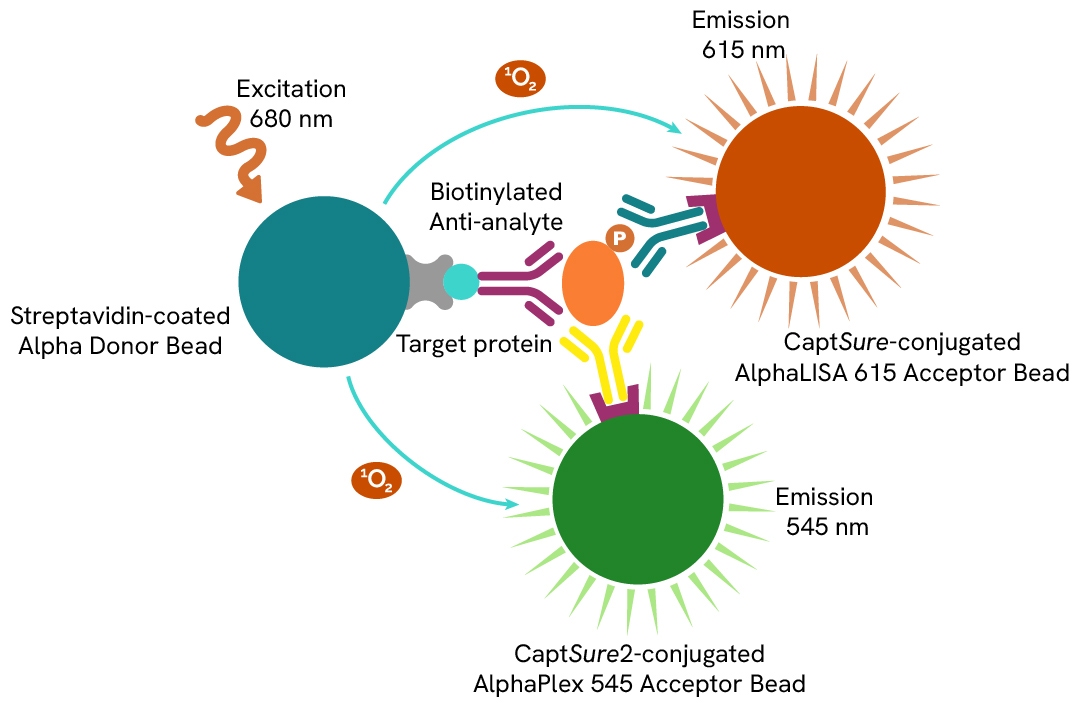

AlphaLISA SureFire Ultra Multiplex Human Phospho-SMAD1 (Ser463/465 & total) Detection Kit, 100 Assay Points
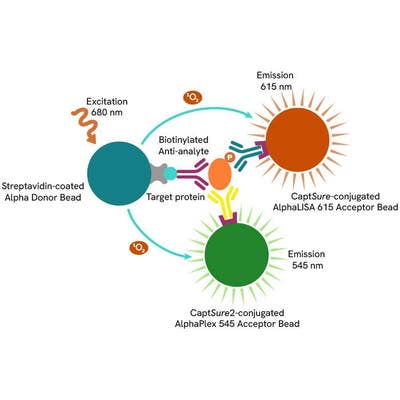
AlphaLISA SureFire Ultra Multiplex Human Phospho-SMAD1 (Ser463/465 & total) Detection Kit, 100 Assay Points
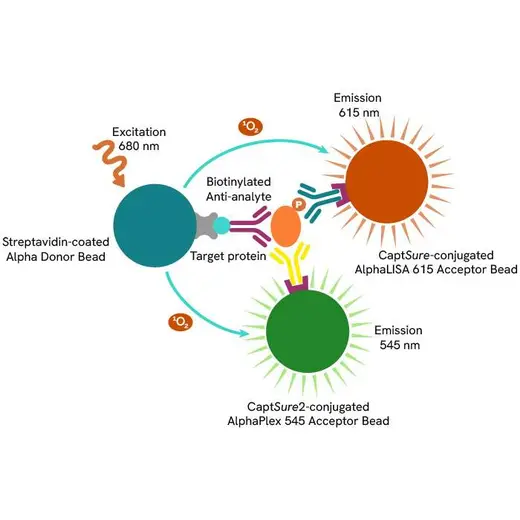
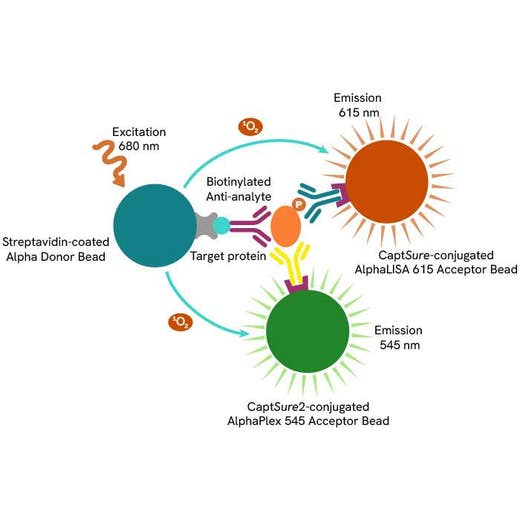
| Feature | Specification |
|---|---|
| Application | Cell Signaling |
| Protocol Time | 2h at RT |



Product information
Overview
SMAD1 is a transcription factor and key mediator of the bone morphogenetic protein (BMP) signaling pathway, which is part of the transforming growth factor-β (TGF-β) superfamily. It regulates genes involved in cell growth, differentiation, apoptosis, and embryonic development. Upon BMP receptor activation, SMAD1 is phosphorylated and forms a complex with SMAD4, translocating to the nucleus to drive gene expression. SMAD1 is essential for early embryonic patterning, particularly in dorsal-ventral axis formation and mesoderm induction, and plays a critical role in osteoblast differentiation and chondrogenesis, making it vital for skeletal development and homeostasis. Dysregulated SMAD1 signaling is implicated in fibrosis, skeletal disorders, and cancers such as glioblastoma and breast cancer.
The Multiplex SureFire Ultra SMAD1 Phospho (Ser463/465) + Total SMAD1 Detection Kit is used to measure both phosphorylated and total levels of endogenous SMAD1 in cellular lysates in a multiplexing AlphaLISA™ no-wash assay. No specially engineered cell lines are required. The 615 nm (Eu) signal corresponds to the phosphorylated SMAD1 analysis, and the 545 nm (Tb) signal corresponds to the total SMAD1 analysis. This kit has been formulated to provide superior signal:background assay windows and to perform without interference in the presence of extraneous antibodies, making it amenable to the study of therapeutic and blocking antibodies.
- No-wash steps, no separation steps
- Multiplexing assay
- No interference from exogenous antibodies
- Results in less than 3 hours
In this assay, the Alpha 615 Acceptor bead is coated with the CaptSure™ antibody, which binds the CaptSure-tagged anti-phospho target antibody. The Alpha 545 Acceptor bead is coated with the CaptSure2™ agent, which binds the CaptSure2 tagged anti-total target protein antibody. The Alpha Donor bead binds the biotinylated anti-total target protein antibody.
How it works
Multiplex SureFire Ultra assay principle
The Multiplex SureFire Ultra assay simultaneously measures phopsho and total protein at a specific level. It utilizes three antibodies that recognize the phospho epitope and two distal epitopes on the target protein. The assay requires three bead types: two distinct Acceptor beads and one Donor bead.
- The Alpha 615 Acceptor bead is coated with the CaptSure™ antibody, which binds the CaptSure-tagged anti-phospho target antibody.
- The Alpha 545 Acceptor bead is coated with the CaptSure2 antibody, which binds the CaptSure2-tagged anti-total target protein antibody.
- The Alpha Donor bead binds the biotinylated anti-total target protein antibody.
When the phosphorylated protein is present, the three antibodies bring the Donor and Acceptor beads close together, allowing singlet oxygen to transfer energy and excite both Acceptor beads. This generates a luminescent Alpha signal at 615nm and 545nm. The 615nm (Eu) signal is directly proportional to the amount of phosphorylated protein, while the 545nm (Tb) signal corresponds to the total protein levels.

Multiplex SureFire Ultra two-plate assay protocol
The two-plate protocol involves culturing and treating the cells in a 96-well plate before lysis, then transferring lysates into a 384-well Optiplate plate before the addition of Multiplex SureFire Ultra detection reagents. This protocol enables the cells viability and confluence to be monitored. In addition, lysates from a single well can be used to measure different targets.
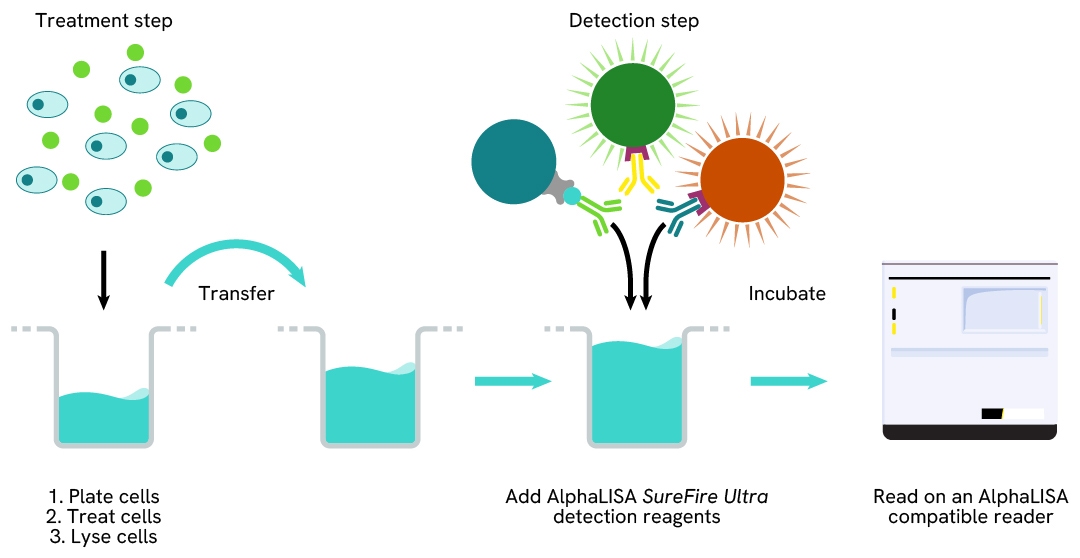
Multiplex SureFire Ultra one-plate assay protocol
Detection of Phosphorylated/Total target proteins with Multiplex SureFire Ultra reagents can be performed in a single plate used for culturing, treatment, and lysis. No washing steps are required. This HTS designed protocol enables miniaturization while maintaining robust AlphaLISA SureFire Ultra quality.
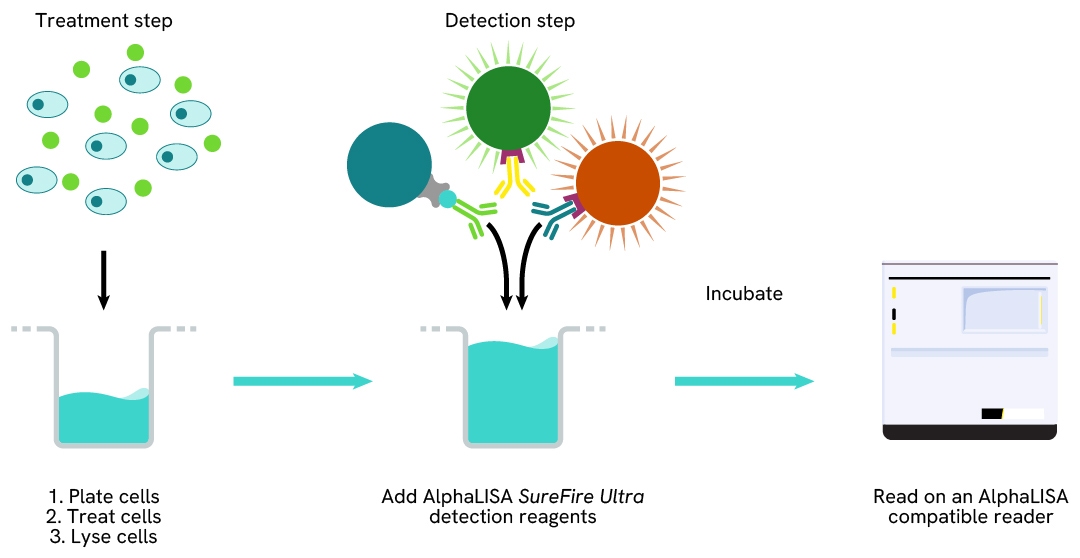
Assay validation
Activation of Phospho SMAD1 (Ser463/465) in endogenous cellular models
A549 or HeLa cells were seeded in a 96-well plate (40,000 cells/well) in complete medium, and incubated overnight at 37°C, 5% CO2. The cells were starved for 2 hours and then treated with increasing concentrations of BMP-4 for 30 minutes.
After treatment, the cells were lysed with 100 µL of Lysis Buffer for 10 minutes at RT with shaking (350 rpm). SMAD1 Phospho (Ser463/465) and Total levels were evaluated in the same well using the AlphaLISA SureFire Ultra Multiplex assay.
For the detection step, 10 µL of cell lysate (approximately 4,000 cells) was transferred into a 384-well white OptiPlate, followed by 5 µL of Acceptor mix and incubated for 1 hour at RT. Finally, 5 µL of Donor mix was then added to each well and incubated for 1 hour at RT in the dark. The plate was read on an Envision using standard AlphaLISA Multiplex settings.
As expected, BMP-4 treatment triggered a dose-dependent increase in the levels of Phospho-SMAD1 (Ser463/465) and no significant changes to Total SMAD1 levels were observed.
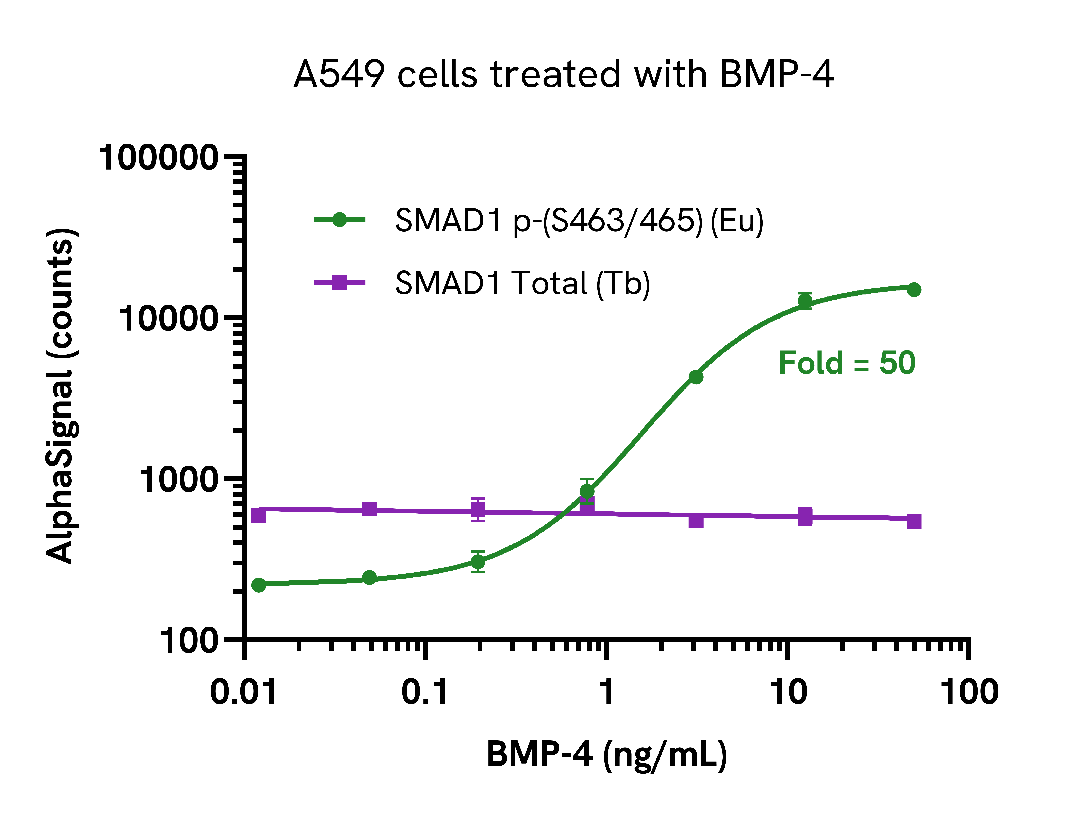
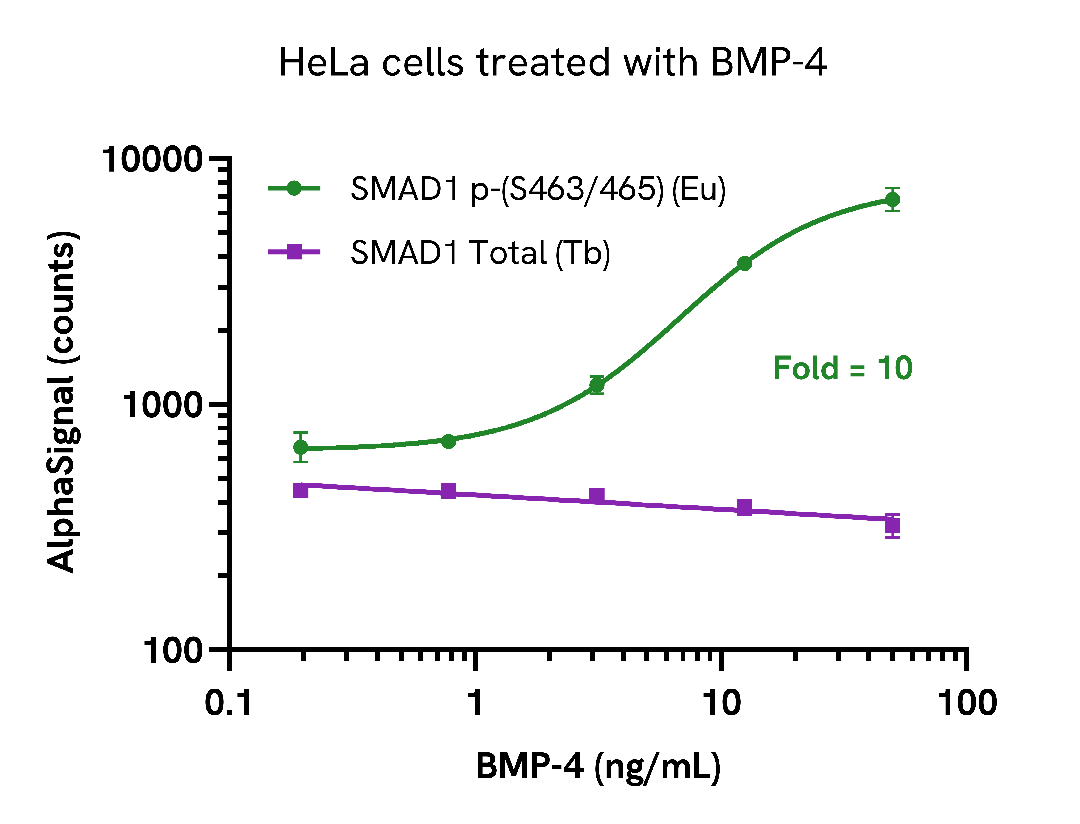
Specifications
| Application |
Cell Signaling
|
|---|---|
| Automation Compatible |
Yes
|
| Brand |
AlphaLISA SureFire Ultra Multiplex
|
| Detection Modality |
Alpha
|
| Protocol Time |
2h at RT
|
| Shipping Conditions |
Shipped in Blue Ice
|
| Target |
SMAD1
|
| Target Class |
Phosphoproteins
|
| Target Species |
Human
|
| Technology |
Alpha
|
| Therapeutic Area |
Oncology
|
| Unit Size |
100 assay points
|
SDS, COAs, manuals and more
Are you looking for technical documents related to the product? We have categorized them in dedicated sections below. Explore now or request your COA/TDS, SDS, or IFU/manual.
- Lot NumberA1852Lot DateJune 19, 2025
- Lot NumberA1884Lot DateJune 19, 2025
- Lot NumberA1880Lot DateJune 19, 2025
- Lot Number-Lot Date-
- Resource TypeManualLanguageEnglishCountry-


How can we help you?
We are here to answer your questions.






























